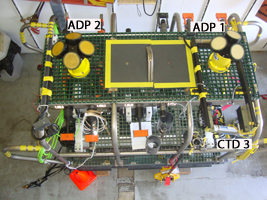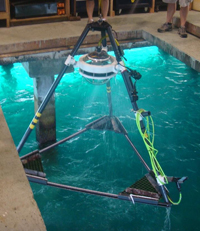Modules and Instrumentation Configuration
The ACO is a prototypical example of a deep ocean observatory system that uses a retired cable.
The ACO architecture uses highly reliable existing transoceanic cable systems to provide power
and communications bandwidth.
The ACO consists of various modules as shown in Figures 1,
2
and 3. A "junction box" (JBOX) is
connected to the telecom cable termination. The JBOX converts the telecom communications protocols to
standard 100 Mb/s Ethernet, and has as well a hydrophone experiment module (HEM) with two
hydrophones and a pressure sensor. Then the "observatory" (OBS) is connected to the JBOX.
The OBS converts the dc current on the cable to 48 V and 400 V, and distributes this, the
Ethernet, and timing signals to eight user ports. On the observatory are two acoustic Doppler
profilers (ADPs), a temperature/conductivity instrument (MicroCat), and a light.
Two additional modules are connected to the Observatory. The AMM (ALOHA-MARS Module) seafloor
secondary node
and the camera. The AMM provides four additional user ports and has two CTDO2s and a
fluorometer/turbidimeter (FLNTU). The camera
with two lights and a hydrophone is connected to the AMM node.
In addition, a 200 m tall
thermistor array/acoustic modem (TAAM) mooring system is installed. This
mooring system has 10 thermistors spaced vertically; these are
battery operated and recording data internally. This system is not connected to the Observatory.
Operational Status of the ACO:
The video camera is working, but the lights have failed. The AMM and its instruments (CTD1, CTD2, FLNTU) are currently disabled.
Figure 1, Top Left. Diagram showing the layout of the ACO modules on the seafloor.
Figure 2, Top Right. Diagram showing the layout of the ACO modules on the seafloor without the TAAM.
Figure 3, Bottom Right. Picture of the ACO (Observatory, JBOX, Camera and AMM) as deployed on the seafloor, taken by the Jason ROV.
(click on thumbnail to enlarge the image)

AMM: The ALOHA-MARS Module (AMM) seafloor secondary node has two Sea-Bird pumped MicroCats (SBE-52MP) measuring Temperature, Conductivity, Pressure and Dissolved Oxygen (CTD1 and CTD2); and a WETLabs Fluorometer/Turbidimeter ECO-FLNTURTD-2027 (FLNTU). This module also provides four additional user ports.
(click on thumbnail to enlarge the image)







